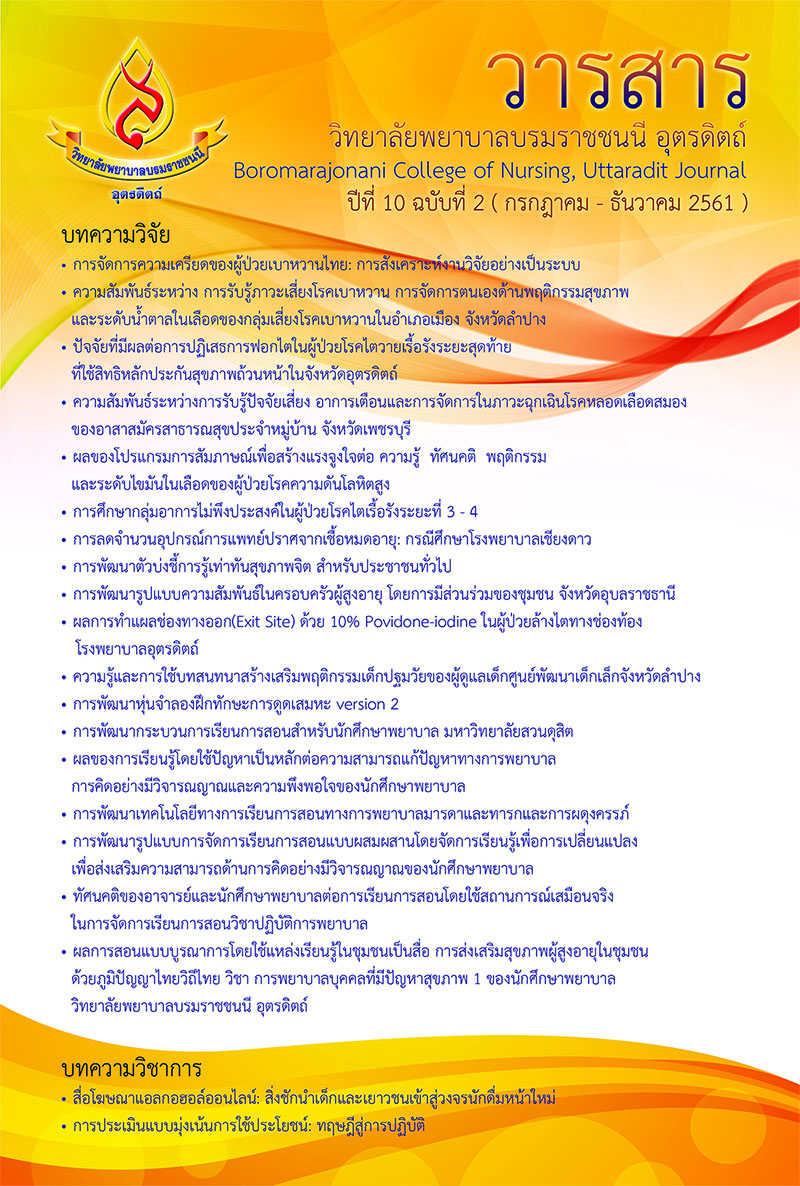ผลของโปรแกรมการสัมภาษณ์เพื่อสร้างแรงจูงใจต่อ ความรู้ ทัศนคติ พฤติกรรม และระดับไขมันในเลือดของผู้ป่วยโรคความดันโลหิตสูง
Main Article Content
บทคัดย่อ
การวิจัยแบบกึ่งทดลอง (Quasi-experimental research) ครั้งนี้มีจุดมุ่งหมายเพื่อศึกษาผลของโปรแกรมการสัมภาษณ์เพื่อสร้างแรงจูงใจต่อความรู้ ทัศนคติ พฤติกรรมและระดับไขมันในเลือดของผู้ป่วยโรคความดันโลหิตสูง กลุ่มตัวอย่างเป็นผู้ป่วยโรคความดันโลหิตสูงที่มีภาวะไขมันในเลือดผิดปกติ จำนวน 60 คน เครื่องมือที่ใช้ในการวิจัย ได้แก่ โปรแกรมการสัมภาษณ์เพื่อสร้างแรงจูงใจ แบบวัดความรู้ ทัศนคติ และพฤติกรรมการป้องกันไขมันในเลือดผิดปกติ การวิเคราะห์ข้อมูลใช้การแจกแจงความถี่ ร้อยละ ค่าเฉลี่ย ส่วนเบี่ยงเบนมาตรฐาน Independent t-test และ Paired t-test ผลการวิจัย พบว่า 1. หลังการทดลองกลุ่มทดลองมีความรู้ ทัศนคติ และพฤติกรรมการป้องกันไขมันในเลือดผิดปกติ ดีกว่ากลุ่มที่ได้รับการพยาบาลตามปกติอย่างมีนัยสำคัญทางสถิติ (p<.05) 2.หลังการทดลองกลุ่มทดลอง มีระดับโคเลสเตอลรอลรวมรวม ไตรกลีเซอไรด์ ลดลงกว่ากลุ่มที่ได้รับการพยาบาลตามปกติอย่างมีนัยสำคัญทางสถิติ (p<.05) และ ระดับเอชดีแอล (HDL) สูงขึ้นกว่ากลุ่มที่ได้รับการพยาบาลตามปกติอย่างมีนัยสำคัญทางสถิติ (p<.05) ส่วน ระดับ แอลดีแอล (LDL) ไม่มีความแตกต่างกันระหว่างกลุ่มทดลองและกลุ่มที่ได้รับการพยาบาลตามปกติ 3. หลังการทดลองกลุ่มทดลองมีระดับความรู้ ทัศนคติ และพฤติกรรมพฤติกรรมการป้องกันไขมันในเลือดผิดปกติ ดีกว่าก่อนการทดลองอย่างมีนัยสำคัญทางสถิติ (p<.05) 4)หลังการทดลอง กลุ่มทดลองมีระดับโคเลสเตอลรอลรวมรวม ไตรกลีเซอไรด์เอชดีแอล (HDL) และ แอลดีแอล (LDL) ดีกว่าก่อนการทดลองอย่างมีนัยสำคัญทางสถิติ (p<.01) การศึกษาครั้งนี้แสดงให้เห็นว่าโปรแกรมการสัมภาษณ์เพื่อสร้างแรงจูงใจสามารถนำไปใช้ในการปรับเปลี่ยนพฤติกรรมและลดระดับไขมันในเลือดที่ผิดปกติในผู้ป่วยโรคความดันโลหิตสูง
Article Details
บทความหรือข้อคิดเห็นใดใดที่ปรากฏในวารสารวิจัยการพยาบาลและวิทยาศาสตร์สุขภาพ เป็นวรรณกรรมของผู้เขียน ซึ่งบรรณาธิการหรือสมาคมศิษย์เก่า ไม่จำเป็นต้องเห็นด้วย และบทความที่ได้รับการตีพิมพ์เผยแพร่ถือเป็นลิขสิทธิ์ของวารสารวิจัยการพยาบาลและวิทยาศาสตร์สุขภาพ
เอกสารอ้างอิง
2. Buranakitjaroen, P. (2015).Thai guidelines on the treatment of hypertension 2012 update 2015. Bangkok: Thai Hypertension Society. (in Thai)
3. Bureau of Non Communicable Diseases Ministry of Public Health. (2012). Curriculum for consultation to modify behavior, reduce risk, reduce the disease for individuals staffs of public health. Bangkok: Agricultural Cooperatives of Thailand Limited Printing House. (in Thai)
4. Konkaew, P.et al. (2011).Factors predicting health promotion behaviors of civil servants with dyslipidemia. Journal of Nursing and Health, 5.(3), 17-27. (in Thai)
5. Maton, T. (2016). Prevention and control of chronic non-communicable diseases and the research that involved. (2nded.). Phitsanulok: Trakoon Thai Printing House. (in Thai)
6. Pangjunan, T. & Pantuvej, N. (2014). The report forecast of hypertension. Bureau of Non Communicable Diseases Ministry of Public Health. (in Thai)
7. Patchapor, A. et al. (2013). Effects of eating behaviors modification model on serum lipid and blood glucose Levels in women with hyperlipidemia. Nursing Journal, 40(3), 14-22.(in Thai)
8. Piya, W. et al. (2013). Effects of motivational interviewing group counseling in health behavior and level of cholesterol of hyperttesive patients. Ratchaphruek Journal, 13(3),91-101.(in Thai)
9. Public Health Office of Uttaradit province. (2014). Summary of annual report Uttaradit provincial health office in 2014. Uttaradit province. (in Thai)
10. Wimal, P. (2016). Dyslipidemia. Bangkok: Chulalongkorn University Press. (in Thai)
Miller, W.R. & Rollnick, S. (2013). Motivational interviewing helping people change.(3rded.). New York: The Guilford Press.


